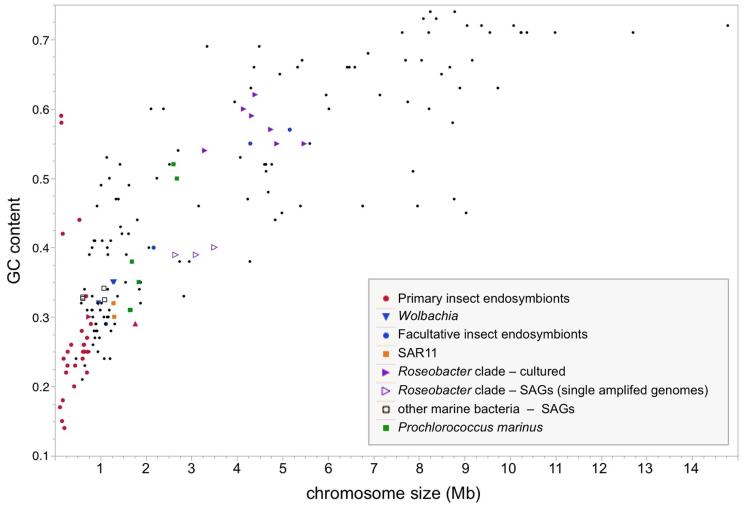Figure 3.
Chromosome size and genomic GC content across select bacterial genomes. The genomes of primary endosymbionts of insects are severely reduced and, with some notable exceptions, AT-rich. Primary endosymbionts shown here represent long-term, intracellular mutualists (red circles), as well as Serratia symbiotica of the cedar aphid (red upright triangle), which represents a very recent transition to obligate mutualism 138, and Ishikawaella capsulata (red sideways triangle), a nutritional mutualist of the plataspid stinkbug that shows striking genome reduction despite being extracellular.139 Intracellular endosymbionts that transfer among insect groups include Wolbachia and facultative endosymbionts. Because facultative endosymbionts tend to possess a high abundance of insertion sequences and pseudogenes, they have a lower coding capacity than suggested by their moderate chromosome sizes. Genomes less than or near ~1 Mb that are unlabeled (black dots) largely represent intracellular pathogens, such as Mycoplasma, Rickettsia, and Chlamydia. Several groups of free-living marine bacteria with surprisingly small genomes are shown, such as SAR11 and Prochlorococcus marinus. SAGs (single amplified genomes, marked with open symbols) typically represent uncultured strains and include representatives of the Roseobacter clade 120 and other marine bacteria.119 Comparisons within the Roseobacter clade show that SAGs have smaller genomes than related cultured isolates.120 For SAGs, genome size and %GC is typically an estimate that is extrapolated from incomplete genome coverage. Data for fully sequenced genomes were downloaded from JGI’s Integrated Microbial Genomes database (http://img.jgi.doe.gov) on August 15, 2014, and estimates for SAGs were obtained from publications.119, 120

